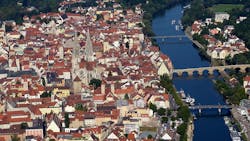Austria’s Ams Osram might be spending nearly a billion dollars on a plant expansion in Malaysia, but that is not stopping it from also enlarging and modernizing LED operations closer to home in Regensburg, Germany, where two German governments are set to provide a €300 million boost.
The Premstaetten, Austria–based LED, laser chip, and sensor maker said that Germany’s federal government and the state of Bavaria will jointly provide the funding to help ams Osram add production lines both for micro LEDs and UV-C LEDs, as well as for near-infrared laser diodes.
Ams Osram did not reveal how much of its own money it is spending on the Regensburg expansion, which has already begun, and which is part of around €1 billion ($1.07 billion) that the company is investing in plants globally including Kulim and Regensburg.
Regensburg has long made optical chips and is already the site of a pilot line for micro LEDs using 8-inch wafers. The plant was part of Osram prior to the then Munich-based company’s July 2020 acquisition by sensor and optical chip maker ams.
The provisional €300 million would help establish permanent 8-inch micro LED fabrication at Regensburg, about 70 miles northeast of Munich — a fellow Bavarian city. The 8-inch machinery is similar to the modern micro LED facilities that ams Osram is adding at its closely watched Kulim, Malaysia facility, where ams Osram is spending roughly €800 million (around $860 million at today’s rate) on an expansion. The move to 8-inch augurs more economical production compared to existing 6-inch wafer processes.
Analysts have been closely monitoring micro LED development at ams Osram. Micro LEDs are much smaller in size than conventional LEDs. They are a centerpiece in the company’s future revenue plans, and are intended to help overcome a recent €1.3 billion write-down amid an ongoing restructuring that new CEO Aldo Kamper refers to as “re-establish[ing] the base.”
Ams Osram says it has landed a commitment for a “substantial pre-payment” on micro LEDs from a customer that it declines to publicly identify. It first revealed the arrangement late last year under previous CEO Alexander Everke.
Ams Osram already has at least one micro LED in the market, the new Eviyos 2.0 pixelated light source for automotive headlamps.
The company is also eyeing other micro LED markets, many of which are display related, such as AR/VR glasses (where lasers are also playing a role), televisions, wearable devices such as smartwatches, and others.
Ams Osram said this week that the €300 million in government support will help Regensburg make micro LEDs “for use in an all-new type of display.” It declined to elaborate on the display. The funding will also go towards production of UV-C LEDs for disinfection, and to near infrared lasers for lidar use in autonomous vehicles, the company said.
Regensburg has been an ams Osram (previously Osram) site for 50 years. The company now has multiple facilities in the city’s Burgweinting section, totaling 26,000 square meters for production as well as research. Regensburg has focused on LEDs for automotive use such as headlights and rear lights, on industrial lasers, horticultural LEDs, and infrared technology among others including the current expansion of micro LEDs and UV-C LED operations. New construction is underway.
The €300 million is “subject to the official notice of the grant,” the company said.
Officials sounded confident that the money would come through, labeling it as a project within the European Commission’s Important Projects of Common European Interest (IPCEI) program aimed at funding digital and green initiatives.
“Ams Osram stands for high tech made in Regensburg,” said Hubert Aiwanger, Bavaria’s minister of economic affairs. “As the Bavarian state government, we deliberately participate in the financing of this IPCEI project. This is fully in line with our intention to further expand Bavaria as a top international location for the semiconductor industry. Every euro is well invested and will create new jobs in a highly innovative environment.”
Funding from the federal government is set to come from Germany’s Federal Ministry for Economic Affairs and Climate Action. Ams Osram said it expects the infusion to lead to 400 new jobs. Regensburg currently has about 2700 employees.
The company also told LEDs Magazine that it aspires to eventually apply the 8-inch wafer process to other optical chips beyond micro LEDs.
MARK HALPER is a contributing editor for LEDs Magazine, and an energy, technology, and business journalist ([email protected]).
Follow our LinkedIn page for our latest news updates, contributed articles, and commentary, and our Facebook page for events announcements and more. You can also find us on the X platform.






